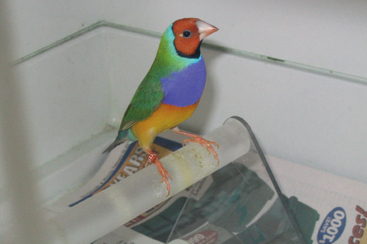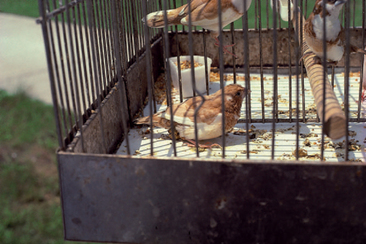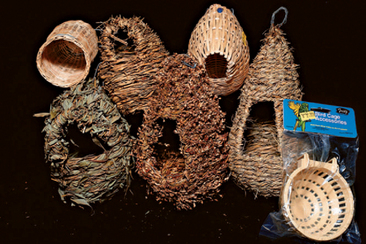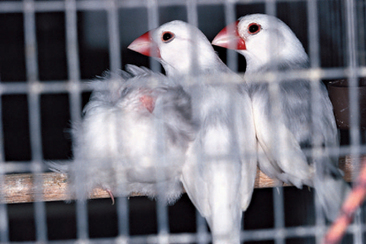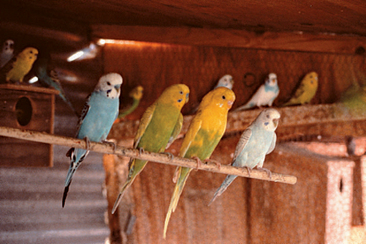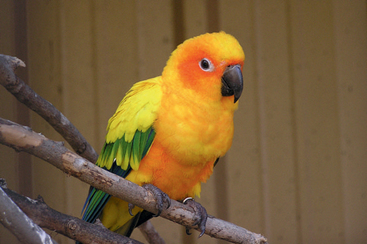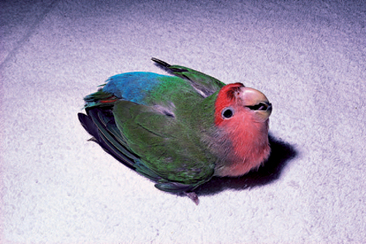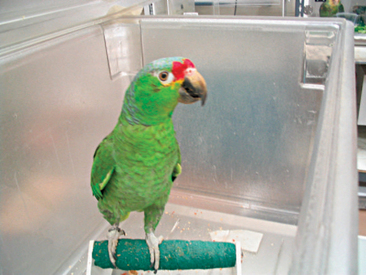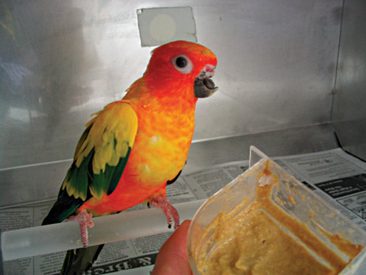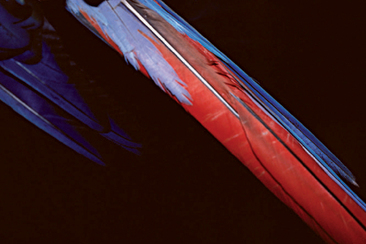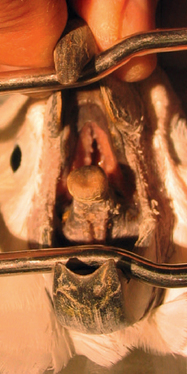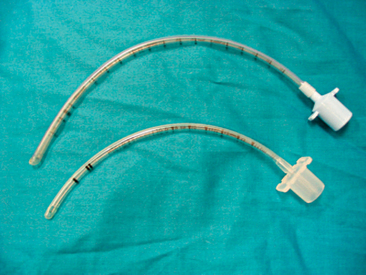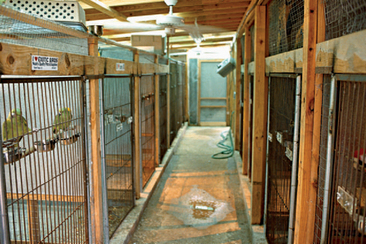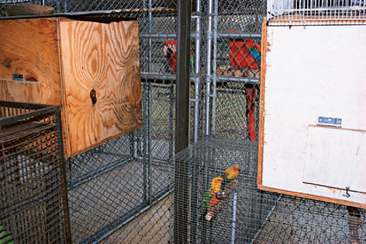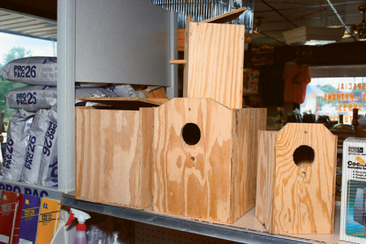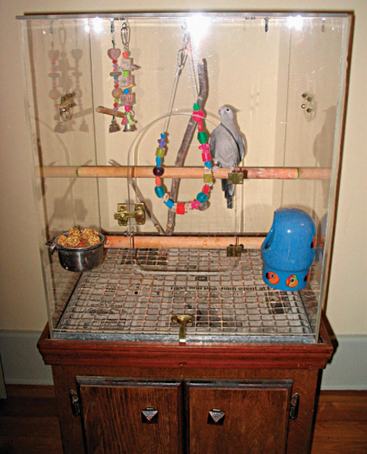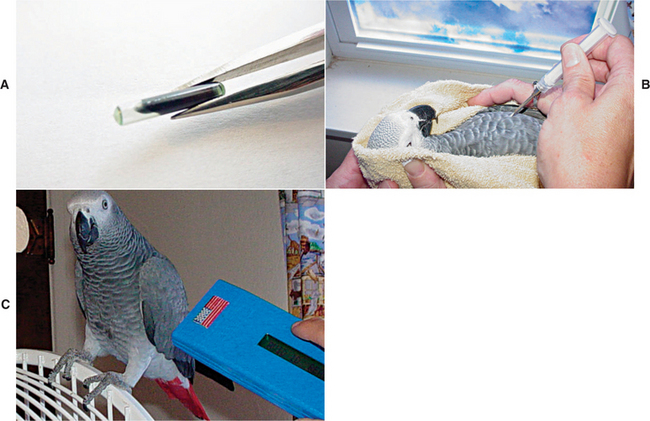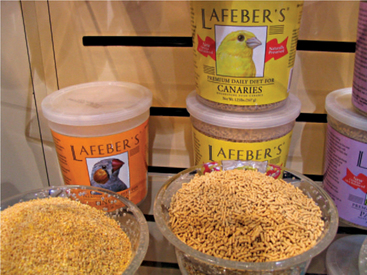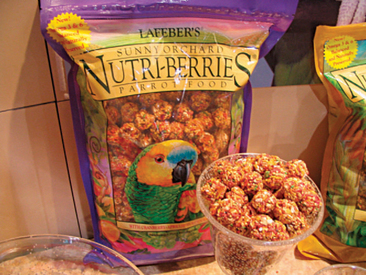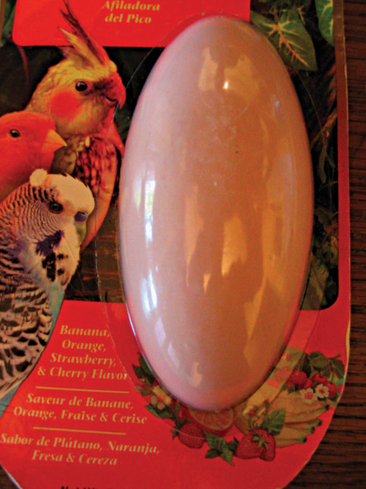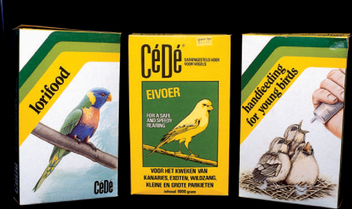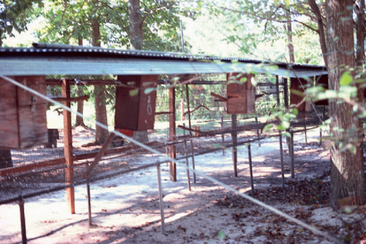CHAPTER 10 BIRDS
COMMON SPECIES KEPT IN CAPTIVITY
Passerine Species
Passerine species usually are cage birds, purchased for their beauty, singing ability, or both.
CANARY
The canary is one of the most popular cage birds because of its singing ability (Figure 10-1). Male canaries sing to attract mates and establish territory. The light cycle has a direct effect on a canary’s singing quality. The canary molts feathers during the longer days of summer and has full plumage for finding a mate and breeding during the shorter days of fall and winter. It is during the shorter days that the male canary sings to find and keep a mate. During the longer summer days it is not unusual for the male canary to stop singing as new feathers are developing.
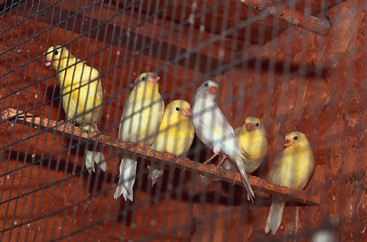
Figure 10-1 Canaries are popular caged birds that are revered for their beauty and singing qualities.
GOULDIAN FINCH
The Gouldian or lady Gouldian, an Australian finch, is one of the most beautiful caged birds. The normal coloration is a red face, olive green wings, purple breast, and yellow belly (Figure 10-2). The male bird has more vivid coloration than the female, and the hen’s beak has a color change from white to gray during the breeding season. This bird is popular with aviculturists trying to develop new color mutations. Accepted color mutations are white-breasted green, lilac-breasted green, pastel green, white-breasted pastel green, lilac-breasted pastel green, blue, white-breasted blue, lilac-breasted blue, and combinations of these colors. There are nonaccepted color mutations, such as cinnamon, sea green, and dilute, but they have not been approved by the Gouldian finch societies at this time. These colorful birds need to have the proper caging and diet to reduce the stress they often exhibit in captivity. High stress levels contribute to poor reproductive results and chronic illness. To increase reproductive success, Bengalese (aka society) finches are used as foster parents. The use of Bengalese finches as foster parents also promotes the exposure of air sac mites, Syngamus trachea, to the Gouldian finch offspring. Air sac mites are one of the most common disease conditions associated with the Gouldian finch and are difficult to clear from an affected animal because of the constant immunocompromised state of the patient in captivity. Strict oversight of appropriate husbandry and dietary issues will aid in maintaining a healthy pet finch or a productive aviary of these attractive birds.
BENGALESE FINCH (SOCIETY FINCH)
The true name of this bird is the Bengalese finch, but it is commonly called the society finch (Figure 10-3). This bird is not found in nature but was developed through the crossbreeding of the sharp-tailed munia (Lonchura acuticauda) and the striata munia (Lonchura striata). This genetic variant has a variety of color patterns of white, brown, and tan. The society finch is best known as an excellent foster parent for Gouldian finch babies, but it also makes an excellent caged bird on its own. These birds are easy to breed and are entertaining to watch when housed together in a group. Although the Bengalese finch is known for its breeding and foster-parenting ability, caution must be used when these birds are sitting eggs or raising babies. Success in producing finch or other avian species offspring is obtained through minimal contact with the parents. It is not uncommon for birds to abandon their nest, eat their eggs, or kill their babies if too much interfer-ence is generated by the owner incessantly checking the nest or nest box.
ZEBRA FINCH
This colorful interactive bird is a popular caged bird. With its red bill and black-and-white tail, the Zebra finch not only is attractive but also appears adaptable to a captive environment (Figure 10-4). Excellent reproductive success, particularly in an outdoor aviary, is one of the positive aspects of owning these birds. As with the society finch, the zebra finch is so prolific that clutch numbers should be regulated to 3 or 4 per season to maintain the health of the adults. There are commercially available nests manufactured for zebra finches, constructed of small rattan slats or grass fiber. These nests usually are oblong in shape and have an opening near the top (Figure 10-5). To discourage egg laying, all nesting material should be removed from the enclosure and/or the nest box taken out. As with the Gouldian finch, color mutations are common with zebra finches. Having a number of birds in a cage or aviary setting will generate lively entertainment along with a pleasant chirping vocalization within the group.
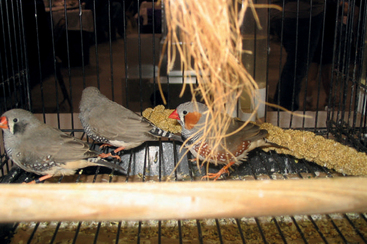
Figure 10-4 Zebra finches have a pleasant chirping sound and are very popular caged birds that are easy to maintain.
JAVA RICE BIRD
The Java rice bird is small, has a large pink beak (Figure 10-6), and is a very popular, inexpensive cage and aviary bird. There are many different color mutations (e.g., white, pied), in part because of their ability to reproduce in captivity. As with other passerine species that breed readily in captivity, it is recommended to limit the clutch size of this bird. Before purchase, one should check with the local wildlife regulations regarding ownership status of this bird. There is a concern in some regions of the country that if released, the Java rice bird will be a future threat to the destruction of grain fields; thus, the ownership of this bird is prohibited in those areas.
OTHER PASSERINE SPECIES
Small passerines require oversight and care, especially in outdoor aviaries. The birds will denude foliage for nesting purposes and have territorial disputes within and outside of species groups. Maintenance of the aviary is required, for keeping the plants healthy, keeping unwanted predators out, and keeping the birds inside. Rats often invade outdoor aviaries and will capture psittacine species when they are roosting at night. Rodents are attracted to aviaries because of the food provided the birds and eventually the birds and eggs themselves. Making an aviary rodent proof will protect birds and eggs and will reduce the stress on breeding pairs that may not mate or may abandon the nest as a response to the presence of vermin.
Psittacine Species
Psittacine species are birds usually purchased for their beauty and companionship.
BUDGERIGAR (COMMON PARAKEET)
The budgerigar (budgie) is commonly called a parakeet in North America (Figure 10-7). Unfortunately, there are many different species of parakeets, so it is in the public’s best interest to differentiate between the species when identifying a bird. To identify this bird within this chapter and for future use, one should become familiar with using the term budgerigar. The normal budgie color is a green body with a yellow head and wings speckled with black over the face. As with the passerine species, there are many color mutations ranging from lutino to blue. A generalized dimorphic characteristic for “normal” green budgies is that the female has a pink/brown cere, whereas the male has a blue cere. One may use the cere color to determine gender in a green color budgie, but this method is not helpful with the various color mutations. A blue budgie with a blue cere may be female. Palpating the distance between the pubic bones with the right index finger may give some indication of gender, females having a wider pubic distance than males.
COCKATIEL
The cockatiel is a small gray bird with a yellow face and orange cheek patch that is recommended for the novice bird owner. Hand-raised cockatiels have many qualities that allow first-time bird owners to interact with their pet and become comfortable with an animal with which they have little or no experience. Cockatiels are small, with an average weight of about 90 grams. Being birds with companionship qualities, they rarely bite, even if there is little interaction over a period of time. Many psittacine species (e.g., lovebirds, parrotlets) often bite their owners and are distrustful unless handled on a daily basis. For the owner that has little time for daily han-dling, the cockatiel is the pet bird of choice. Cockatiels can be reproductively active, with female birds laying eggs on a regular basis if comfortable with their environment and diet. There are many different color mutations for cockatiels, with gray being the normal color. Male gray cockatiels are darker gray, have a brighter yellow head and a bright orange cheek patch. Female gray cockatiels have more muted colors than males, and the ventral aspect of their primary and secondary flight feathers have transverse white bars. In general the birds with color mutations have fewer gender-differentiating characteristics. As with any bird, if there is no male in the enclosure, all eggs laid by the female are infertile. For the pair of birds that lay fertile eggs, a wooden nest box will be adequate for the hen to deposit eggs and raise the young. Clutch numbers should be regulated to 4 or 5 a year because a cockatiel pair will lay all year. A calcium source (e.g., cuttlebone) is required for adequate nutrition, and as with all psittacine species, a base diet consisting of extruded pellets is recommended. Seed treats (e.g., Nutriberries, Lafeber Company, Ordell, IL), along with vegetables and fruit, will provide a diverse diet that increases nutritional offerings and are psychological stimuli for the bird. Normal gray cockatiels have an average life expectancy of 16 years, with the more inbred color-mutated birds having shorter average life spans.
CONURE
Conures may be considered small parrots (Figure 10-8). This group of birds can be divided into pyrrhua (e.g., maroon-bellied, white-eared) and aratinga (e.g., red-masked, jendaya, sun, blue-crowned). In general, the pyrrhura are less noisy and make better companion animals, with the exception of the aratinga blue-crowned conure. Conures are popular companion avian species because they are beautiful, have “talking” capabilities, are a relatively small group of psittacine birds, and are relatively inexpensive. Unfortunately, because of their relatively low price, many novice bird owners purchase conures without performing the proper research on their new pet. Most conure species have beaks that are large enough to inflict a serious bite injury to the owner. These birds are independent, even when hand-raised, and may bite without any provocation. The arantinga group can be beautiful (e.g., sun conure, jendaya) but are often so vocal that they present a significant distraction and disturbance to their owners. The exception, again, to the vocal aratinga group is the blue-crowned conure. A blue-crowned conure was used as the bird actor for the movie Paulie. Many conure species successfully reproduce in captivity and are readily available for the pet trade. Conures are small parrots and need adequate cage space and appropriate toys for their powerful beaks. Most conures have an average life span of 20 to 25 years.
LOVEBIRD
Lovebirds are native to central and southern Africa and Indian Ocean islands and weigh approximately 50 grams. There are a number of species of lovebirds, but the peach-faced and black-masked are the most common (Figure 10-9). Even though both the peach-faced and black-masked are lovebirds, they build their nests using very different methods. The peach-faced lovebird places nest material in its rump feathers and then flies back to the nest box and makes a concave nesting cavity with the material. The black-masked lovebird carries nest material in its beak and then builds a nest by filling the cavity with material and tunneling through to the nesting chamber. Lovebirds are aggressive and have to be handled on a daily basis to retain their companionship qualities. Only hand-raised lovebirds that are maintained as single birds are recommended as companion animals. These birds are often promoted as Valentine’s Day gifts, to be purchased as a pair. It is often stated by the salesperson that it is best to purchase a pair of birds for their well-being and health. Lovebirds do not need to be purchased in pairs nor maintained as a pair of birds. Lovebirds that are purchased as a pair will make very poor interactive pets for the new owner. Most psittacine species should be maintained as either a companion animal or breed ing animal. Rarely does a breeding animal make a quality companion animal. Of course, the single companion bird will not provide fertile eggs or lay eggs at all if a male. Birds will trust and interact with their own species much better than with the human owner if given a choice. The single, hand-raised lovebird that is handled daily makes a very good companion animal. Lovebirds have an average life span of 15 years.
SOUTH AMERICAN PARROT
Typically when one thinks of a pet bird, the vision of a pirate comes to mind with a large green parrot on his shoulder. Large parrot species exist from the southwestern United States (e.g., thick-billed parrot) to Argentina (e.g., Quaker). The most common South American parrots sold for companion animals are the yellow-headed parrot species and Central American parrot species. The green-cheeked, yellow-cheeked, and lilac-crowned Amazon parrots are common Central American species, whereas the yellow-nape, double-yellow-head, and blue-front Amazon parrots may be considered common South American parrots maintained in captivity (Figure 10-10). Although many of these species have overlapping territories, these birds are found from Mexico into South America. South American parrots are relatively difficult to reproduce in captivity, but experienced aviculturists have been able to keep up with the demand for domestic, hand-raised babies since the cessation of wild bird imports into the United States in the early 1990s. In general South American parrots can make excellent companion animals but are extremely vocal during the early morning and early evening hours. These birds can mimic human voices and interact with their owners. With their large beaks, if frightened, these birds can seriously injure their owners. Amazon parrots are seasonal breeders, with reproductive activity at its height during the spring months. Male parrots are very temperamental during this time; mild-mannered birds may become aggressive and are prone to unprovoked attacks on the owner. This activity has led to owners searching for behavior modification options to prevent this hormonally induced aggressive behavior. The popularity of Amazon parrots as pets has produced an active illegal smuggling operation on the U.S. border with Mexico. To enhance a bird’s value in the eyes of an uneducated buyer, the bird smugglers will bleach a green parrot’s head feathers yellow. This bleaching process will not affect a parrot’s underlying skin in most cases, but it can cause a severe dermatitis if the bleach is not applied properly or with a great deal of care. Small conures and parrots that have had have their heads bleached as adults have been offered for sale as baby yellow-head Amazon parrots. A program sponsored by the United States Fish and Wildlife Service (USFWS) and the United States Department of Agriculture (USDA) takes confiscated birds and puts the birds through the required quarantine procedure. After the birds have been successfully quarantined for exotic Newcastle disease and are disease free, they are auctioned off at sanctioned events with proceeds supporting the efforts of the USFWS and USDA. A common disease presentation noted in the captive Amazon parrot is obesity. A regulated diet and exercise, if possible, are highly recommended to maintain a companion animal with a healthy body condition. The average life span of South American parrots is 35 to 40 years.
COCKATOO
Cockatoos are native to Australia and the surrounding south Pacific Islands. As a group of birds, cockatoos are classified as black (e.g., palm, gang gang) and white (e.g., umbrella, salmon crested, sulfur crested). As companion animals the black cockatoos are extremely expensive and rare, whereas the white cockatoos are considered a common large pet bird. White cockatoos are easily reproduced in captivity and have the ability to mimic the human voice and inanimate objects. The characteristic that makes cockatoos a desirable pet is also the source of owner disappointment: the intense companionship quality of the single pet bird. It has been said that a cockatoo’s main goal in life is to become physically attached to its owner. If an owner’s time interacting with the bird satisfies the animal’s apparent need for companionship, then there are relatively few behavioral problems that will develop with the bird. If the bird desires more time with the owner than can be provided, behavioral problems will be common among white cockatoo species, including screaming and neurotic feather picking. Screaming occurs when the bird wants attention but the owner is unwilling or unable to meet the bird’s demands. Cockatoos are large birds with loud vocal abilities, and the screaming produced is very disruptive to the household. Psychological feather picking is a physical response to stress within the bird’s environment. There are many conditions that can increase the stress level of cockatoos, one being the inability to meet the bird’s demand for companionship interaction. As mentioned previously, it is imperative that potential owners educate themselves regarding the characteristics of the birds they are considering for companion animals and how the birds will adjust to their lifestyle. Through prepurchase education, the result of the ultimate decision will not only satisfy the new owner but their avian companion as well. The average life span of a cockatoo is 30 to 45 years.
ECLECTUS PARROT
This beautiful bird is found on the South Pacific islands and in Australia. The unusual characteristic of the eclectus parrot is the dimorphic color characteristics of the male and female. The male is bright green, and the female is red (Figure 10-11). When the eclectus parrot was first discovered, aviculturists believed the male and female were two different species. The eclectus parrot, in general, is a very good choice for a companion animal. Aggressive behavior, minimal mimicking ability, and a propensity for psychological feather picking are traits that potential owners should consider before owning these beautiful birds. It is the beauty of the eclectus parrot that draws the interest of potential owners. The birds commonly reproduce in captivity and are hand-raised for the pet market. The availability of the birds makes them easy to obtain. Aviculturists who successfully reproduce eclectus parrots are also aware that the female will abuse, and sometimes kill, unwilling or nonaggressive male birds. Great care must be followed when setting up breeding pairs of eclectus parrots to prevent cage mate mortality.
BIOLOGY
Beak
Birds have a number of anatomic and physiologic parameters that separate them from mammalian species. The most obvious is the bill and feathers. The bill, or beak, is a complex anatomic structure. The upper beak is attached to the frontal bone with the craniofacial hinge, whereas the lower mandible is attached through the articulation of the articular and quadrate bones.1 Passerine and psittacine beak anatomy is a complex system of support and germinal epithelium. Bone is the foundation of the beak and is covered by a vascular layer and the germinal epithelium, which is covered by the keratinized epidermis called the rhamphotheca.1 The rhamphotheca is subdivided into the rhinotheca of the upper beak and the gnatotheca of the lower beak. The complex structure of the beak poses a problem to medical personnel trying to correct beak injuries or loss. The beak will not regrow if a substantial section of the beak has been traumatically removed or if the beak sloughs because of a disease process (Figure 10-12). The beak will heal at the interface of the damage and viable tissue, but it will not regenerate to its original size and shape. The pressure applied by the animal when climbing or eating adversely affects the ability of a beak prostheses to stay attached for any period of time. Many companion avian species will be able to adapt to dietary modifications if they are unable to eat a normal diet as a result of a severe beak injury. Working with an affected patient to adapt to its challenged condition should be the first priority of veterinarians and owners, not euthanasia.
Feathers
All birds go through a process of growing what are called blood feathers. The emergent feather shaft is filled with blood, which brings nourishment to the developing feather. The most obvious blood feathers are the large primary and secondary wing feathers, remiges, and major tail feathers, retricies. During the growth phase, the feathers are innervated and will be painful to the bird if cut or traumatized. Once developed, the bird will not experience pain when feathers are cut, only if forcefully pulled from the follicle. If there is generalized stress to the animal during the feather growth phase, feather growth will be adversely affected. This adverse affect will be noted in the mature feather as transverse lines (Figure 10-13). These transverse lines are disruptions in the barb and barbule architecture due to the increase in the endogenous corticosteroid production caused by stress.
Respiratory System
The upper respiratory system in the bird begins with the nares, and within the nares is the visible operculum or keratinized flap. Avian species have only one sinus, the infraorbital sinus, with many diverticula within the head. The infraorbital sinus is extensive once the upper airway passes the nares and conchae. The terminus of the upper respiratory system is the choana leading to the choanal slit. The choanal slit is the interface between the upper airway and oral cavity. The choanal slit is a V-shaped structure in the dorsal surface of the oral cavity, with the base of the V being most rostral (Figure 10-14). Lining the choanal slit are epithelial projections that are easily eroded during an infectious disease process and/or when irritated.
When intubating a bird, a decision must be made to determine which style of tracheal tube should be used. If an endotracheal tube is used with an inflatable cuff, the anesthetist can be assured of a proper fit. The inflatable cuffed endotracheal tube is a concern when used on animals with closed tracheal rings because of the possibility of pressure necrosis occurring at the site of the cuff. It is recommended to use noncuffed endotracheal tubes on avian patients to prevent the occurrence of pressure necrosis (Figure 10-15). If noncuffed endotracheal tubes are used, it is imperative that the veterinary surgeon selects the proper size to ensure a tight fit. The proper sized noncuffed endotracheal tube will allow the use of a ventilator and a respiratory monitor and will prevent the aspiration of blood or ingested food.
Digestive System
The cervical esophagus extends from the crop into the proventriculus, or true stomach, which produces hydrochloric acid and pepsin. Major digestive processes occur within the proventriculus. Ingesta leaving the proventriculus enters the ventriculus, where it is mechanically broken down. In most instances companion avian species do not need grit to break down the ingested food. If a toxic foreign body (e.g., lead, zinc) enters the ventriculus, it is difficult to remove. Between the proventriculus and ventriculus is the intermediate zone, a transitional section of the gastric anatomy that is lined with interfacing proventricular and ventricular mucosa. This section of the stomach is most often cited as the primary location of gastric tumors.2 The ventriculus in avian species is more developed in birds that use it as a grinding organ (e.g., chickens, pea fowl, pigeons). To grind the food, a bird ingests grit. Grit can be defined as a nondigestive tool that is ingested and used to break down food. Companion avian species and common cage birds do not need grit to digest their food. This is truer today because of the availability of processed avian diets. The ventriculus is lined with a hard kolin layer consisting of a hardened carbohydrate protein matrix. The kolin layer hardens when exposed to the hydrochloric acid from the proventriculus and obtains its color from the retrograde movement of small intestinal biliverdin.2 The grinding process of the ventriculus is aided by rotating the food in this muscular organ. There are four quadrants of muscle that comprise the ventriculus. The muscle thickness rotates between quadrants, switching from thick (cranioventral, caudodorsal) to thin (craniodorsal, caudoventral). The different muscle thicknesses aid in the digestive process of birds but make it difficult to remove ingested foreign bodies.
The small intestine begins after the ventriculus. The pancreas is located within the descending loop of the duodenum. Both pancreatic and bile ducts open into the duodenum.2 There may be two or three pancreatic ducts, depending on the species.2 Bile ducts enter the intestine from the gall bladder (cysticoenteric) in some birds; in birds with no gall bladder (e.g., Amazon parrot, ostrich), bile ducts enter the intestine from the liver (hepatoenteric duct).2
Reproductive System
The reproductive organs of birds (testis and ovary) are located at the cranial pole of the kidney, caudal to the adrenal gland. In companion and cage birds the female has one ovary, located on the cranial ventral aspect of the left kidney. The ovary is connected to the urodeum by the oviduct. The oviduct is divided into five sections: infundibulum, magnum, isthmus, uterus, and vagina. The developing egg remains in the uterus longer than in any other section of the oviduct, and it is in the uterus where the egg shell is formed. The male bird has two testes, and they are connected to the urodeum by the ductus deferens. Companion and cage birds have a nonintromittent or nonprotruding phallus.2
Renal System
Birds are uricotelic, the end product of nitrogen metabolism is uric acid.1,3 The three-lobed avian kidney is located within an area of the dorsomedial coelomic cavity. The kidney lobes are situated within and against the ventral aspect of the cranial rib and vertebral surface. Birds do not have a bladder or urethra; instead, urine enters the urodeum through the ureters. A renal portal valve is found within the lumen of the common iliac vein, and when the valve is open, blood flows into the caudal vena cava, away from the kidney tissue.1,3 There are two types of nephrons within the avian kidney: cortical (reptilian) and medullary (mammalian).1,3 The cortical nephron, which is found in the greatest number of bird species, lacks a loop of Henle, whereas the medullary nephron has a loop of Henle.
HUSBANDRY
Environmental Considerations
One of the most important owner influences on a bird’s health is its environment. An environment that promotes psychological well-being leads to a happy, healthy, reproductively active bird. For small cage birds, a large cage or aviary will allow for flight and space needed to reduce territorial stress that is often associated with common species maintained in captivity. Overcrowding will lead to injury and stress. Aviary design is often based on an individual’s imagination and monetary investment. Aviaries can be small areas within a house or large outdoor flights (Figure 10-16). Large free flight aviaries require plants for hiding, perception of safety, and building of nests. Maintenance is often required with the free-flighted aviaries because small birds have a habit of pulling the leaves off the plants and trees within the enclosure. As with all aviaries, rodent and vermin control is important. Rodents and insects are drawn to the food debris produced by pet birds. Bird food not stored properly is also a magnet for rodents and insects. In the southeastern United States, fire ants, drawn to an aviary by spilled food, are potential deadly pests to young chicks. Roaches, found in many aviaries and houses, are the intermediate host for Sarcocystis falcatula. Food debris will draw pests, and the nutritional composition of bird food degrades when exposed to the environment, especially heat. Storage of bird food is important to maintain nutritional integrity and prevent the introduction of pests. People that establish large outdoor aviaries may desire individual flights that are occupied by a single pair of birds. The paired flight cages are set up in most cases for breeding purposes. Food and environment have an effect on the success of breeding pairs producing offspring. Knowledge by the bird owner is essential on what is needed to give the pair the best opportunity for successful reproductive activity by that particular species. Information on nest box size is important, as is the material from which the nest box is made (Box 10-1).

BOX 10-1 Minimum recommended sizes for nest boxes in a psittacine flight
Rights were not granted to include this box in electronic media. Please refer to the printed book.
From Clubb SL, Flammer K: The avian flock. In Ritchie BW, Harrison GJ, Harrison LR, editors: Avian medicine: Principles and Application, Lake Worth, Fla, 1994, Wingers.
All nest boxes should have an observation door so that owners can view the interior with minimal disturbance to the bird (Figure 10-17). It is important for bird owners to view the inside of the nest box for laying activity and egg production. Once the eggs hatch, proper development of the babies should be monitored and the babies pulled if treatment is needed or if hand-feeding is required. Some birds like a wooden nest box in an elongated shape with the hole near the top (Figure 10-18). Some species, such as macaws and cockatoos, will “modify” their nest boxes by chewing wood; this activity may stimulate reproductive activity. If the breeding pair is too destructive to the nest box, material such as sheet metal can be used to build the structure. It is important to make sure that smooth slick surfaces on nest box bottoms are lined with wood chips to ensure proper positioning of legs during the rapid skeletal growth of young birds. Slick nest box bottoms lead to splay-legged birds and other developmental abnormalities that affect the joints and long bones of the legs. Hardwood chips are recommended for lining the bottom of the breeding box because they do not produce the volatile oils associated with softwoods (e.g., cedar, pine). The volatile compounds cause irritation to the respiratory system and exposed dermis of both parents and baby birds. For species in which there may be cagemate trauma or death (e.g., cockatoos, rosellas, eclectus), two-holed T nest boxes allow for the mate to escape if being attacked. Other recommendations to prevent cagemate trauma include trimming the aggressive mate’s wings so that the bird being attacked has better flight capabilities. Custom-made, outdoor flights for aviaries should be made out of wire produced especially for that purpose. Custom-made indoor cages can be painted with nontoxic paint, but owners should be aware that over time the bird will probably pick at the paint, affecting the overall look of the enclosure. The most common cage material for outside cages is galvanized caging wire that is produced in sheets and cut to form the appropriate cage size for the bird(s) to be housed. The cut wire sections are then held together using binders called “J” clips. This galvanized cage wire may lead to zinc toxicosis through birds scraping the wire with their beak and ingesting the galvanized pieces. The galvanized protective coating can also be leached into water droplets that form on the wire and are then licked off by the birds. To reduce the amount of excess galvanized coating on new wire, washing with vinegar and abrading the cleaned material with a wire brush are recommended. There are many different types of cages available commercially for the bird that is to be housed inside, with the main options being metallic bars and acrylic. Stainless steel cages are of the highest quality cage material that can be used for companion bird enclosures. Stainless steel is usually not painted and does not rust. The most common cage material used for indoor psittacine enclosures is powder-coated steel. These powder-coated cages are available in many colors and sizes. Smaller cages may be nickel or brass-plated wire that can become dull after the clear coat finish ages or is disturbed by the birds. It is imperative that all bird cages have appropriate space between the cage bars to prevent the animals from getting their head stuck between the bars (Box 10-2).

BOX 10-2 Recommended cage bar spacing for psittacine species maintained as companion animals
Rights were not granted to include this box in electronic media. Please refer to the printed book.
From Gallerstein GA: The Complete Pet Bird Owner’s Handbook, Minneapolis, 2003, Avian.
There are many specialty cages using a variety of material for cage bars. Research is required to make sure the size and material are suitable for the bird being housed. This also applies to cage furniture, perches, and bowls (e.g., food, water). Cages and aviaries that contain small birds must be easy to clean and must be easy for the owner to change the food and water. Perches can be made out of hardwood or formed plastic. Appropriate perch material is recommended to prevent ingestion of foreign bodies leading to gastrointestinal disease. A natural hardwood (e.g., oak, hickory, maple) perch offers various diameters for birds to grasp, exercise their feet, and chew; also, they are inexpensive and can be readily replaced (Box 10-3).

BOX 10-3 Recommended perch diameters for cage and aviary birds
Rights were not granted to include this box in electronic media. Please refer to the printed book.
From Gallerstein GA: The Complete Pet Bird Owner’s Handbook, Minneapolis, 2003, Avian.
For water, a bottle with a stainless steel sipper tube is best for birds. This type of watering system allows for easy access for refilling and cleaning and also prevents the bird from defecating in its water supply. If a water bottle with a sipper tube is not used, there are ceramic water receptacles that attach to the side of a cage with a hole in the side. This design also reduces defecation into the water receptacle (Figure 10-19). Food dishes containing pelleted food, seed, fruit, and vegetables should be easy to remove, difficult for the bird to turn over, and easy to clean and disinfect. Stainless steel is the material of choice for food dishes, but thick ceramic bowls are also acceptable. Heavy plastic is appropriate for small bird bowls and is the food and water receptacle material of choice for passerine species. Food and water should be changed daily, and depending on the bird, the cage should be cleaned every 2 to 3 days. There are many different cage substrates used to line the bottom of pet bird cages. The cage substrate of choice is newspaper because it allows the owner to see the bird’s stool for evaluation, and it is inexpensive and readily available. Newspaper also becomes dirty, which is apparent to the owner, indicating a need to clean the cage. If other cage substrates are used (e.g., crushed corn cob, ground walnut shell, and shredded paper), it is difficult to determine how dirty a cage may be; these substrates can hide the extent of fecal and urine buildup, often prolonging the perception of a clean cage. The best disinfectant for cleaning bowls, toys, and cage furniture is dilute sodium hypochlorite, or household bleach. It should always be remembered that dirt cannot be disinfected. To properly disinfect a cage or material within a cage, organic material first must be removed from all surfaces. After the organic material has been removed, the action of the disinfectant can be effective in cleaning the surface to which it has been applied.
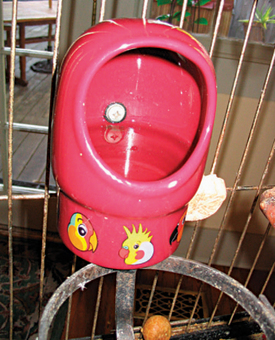
Figure 10-19 An example of a protected water source. The overhead protection reduces exposure to fecal and food contamination.
Lighting is important for canaries, because their molting and breeding is directly correlated to the length of daylight to which they are exposed. During the summer (long daylight hours), canaries molt and will stop singing. When the daylight hours wane (autumn, winter), the feathers are in place and the bird sings to attract a mate. Shortening a cockatiel’s exposure to daylight has been recommended for cessation of egg laying. Indoor birds should be exposed to artificial, full-spectrum light (UV-A and UV-B) to enhance breeding activity and vitamin D metabolism and subsequent calcium absorption from the gastrointestinal tract.6 The bulbs should be placed within 12 inches of the animals, turned on for at least 1 hour every 24 hours, and replaced every 6 months.6 Birds prefer to go to sleep at sundown and awake at sunrise. If a bird’s cage is in a room in which a family watches television and is light well into the night, a cage cover is recommended. A cage cover is not required for pet birds, but if used, it should be part of the nightly routine and removed early in the morning. One should remember that birds are much more susceptible to heat than cool weather or “drafts” within a house. If birds are allowed to acclimatize during the temperate autumnal season, down feathers will grow in under the cover feathers, increasing the animal’s ability to withstand cool weather. Birds will play in the snow or stay outside of a nest box when temperatures are below freezing if they are properly acclimatized. Birds have a normal body temperature of approximately 103° F and have little ability to dissipate environmental heat. External heat generated within a bird’s environment is considered dangerous, and the animal should be removed as soon as possible. An acrylic cage with very little ventilation generates elevated temperatures within that space when placed in direct sunlight (Figure 10-20). If acrylic cages are used, they must be placed away from direct sunlight. Cages should never be placed in a kitchen or in an area that will disturb the bird when it is sleeping. Kitchens are the area in which vapors generated from cooking are emitted, and many are toxic to a bird’s sensitive respiratory system.
Identification
There are currently two specific methods for identifying birds: leg bands and microchips. It is required by law that birds be identified, and either leg banding or microchips within the pectoral muscle are acceptable. Leg bands are the most common method for bird identification. Closed or open bands can be purchased by the breeder and placed on a young bird’s leg shortly after hatch. It is easy to place a band on a bird’s leg when the bird is young because the bones are pliable and the foot joints have more laxity early in life. Oversized closed leg bands or open bands can be placed on an older bird. Information on leg bands includes the year, owner’s initials, and a statement that the animal was hatched. The benefits of identification are somewhat diminished because leg bands pose a health risk due to the possibility of the bird getting the band entangled in cage wire or toys. Even if the bird is able to free itself from entrapment, the result of the injury can lead to swelling and vascular impingement, resulting in foot necrosis distal to the band. If at all possible, leg bands should be removed to prevent injury or possible death to the bird. Placing a microchip in the pectoral muscle is the recommended identification method for companion avian species. The microchip (Figure 10-21) most commonly used to identify pet birds is the AVID microchip system (AVID Microchip ID Systems, Folsom, LA). Microchips can be placed successfully in birds weighing more than 150 grams. For birds that weigh less than 150 grams, leg bands are the identification method of choice.
NUTRITION
A bird’s diet is one of the most important factors affecting its health. Health is directly correlated to quality of life and life span of that animal. There are many different species of birds that can be classified as companion animals and cage birds. Each avian species has its own nutritional requirement, and owners are encouraged to research the proper diet for their bird(s). For companion avian species and caged birds, a base pelleted or seed diet is recommended and should be fed ad lib. Pelleted diets are manufactured using two processes: bound and extruded. With bound pellets the food material is finely ground and mixed with a substance that under pressure and pressed will form a pellet. In most cases with bound pellets, the food material is not cooked. Extruded pellets start with a very finely mixed batter of food ingredients that is cooked and pressed through a processing machine into shapes. Bound pellets retain much of the food ingredients’ color and smell after they are made, whereas extruded pellets come in different shapes and colors and may have a sweet odor (Figure 10-22). Pelleted diets come in a variety of sizes and should be selected based on the size of bird being fed. One disadvantage for feeding multicolored pellets is the bird may select certain colored pellets and not eat others. Selection of specific colors or shapes is expensive and leads to waste. By offering multi colored pellets that have different shapes, a bird is psychologically stimulated by the offering. A proper diverse diet is not only psychologically stimulating, which leads to a high quality of life, but is speculated to improve reproductive activity within an aviary.
Seed-based diets have been the staple of cage bird nutrition for many years. The advent of pelleted diets has improved owners’ ability to provide a better balanced diet to their bird without having to offer vitamin and mineral supplementation. Not every bird will eat pelleted diets, although there are bound pellets with large pieces of exposed food bits that may be considered a formulated dietary offering. Some avian species, including many canary and finch species, require seed as their base diet. Providing the seed diet not only is natural to the bird but also delivers the nutrients that its body requires. For many psittacine species, seeds are considered a treat to be offered in small quantities. Most seed diets are high in fat content and have low quantities of other essential elements. Seed-based diets for canaries contain millet, rape, niger, sesame, hemp, and linseed, among other seed varieties. Many of the psittacine diets, including those developed for cockatiels, parrots, and macaws, have a high percentage of sunflower seeds, safflower seeds, or both. For the larger birds, including macaws, nuts (e.g., peanuts, hazelnuts, almonds) are added to the commercial diets. Some pet stores offer individual seeds that can be mixed into a homemade diet. To check for freshness of the seed, a sample of the product can be placed on a wet towel to observe for sprouting. Most birds, even the small caged birds (e.g., canaries, finches), will shell the seed before ingesting the kernel. To prevent seed waste, sifting the uneaten seed from the hulls will save money and reduce the amount of food discarded. Seed will degrade in nutritional quality over time, especially if exposed to heat and sunlight. Keeping seed cool will extend its shelf life. Insects, especially seed moths, can infiltrate storage containers. Keeping the seed in insect-proof containers in a refrigerator is a recommended method for reducing seed moth infestations. For psittacine species in which a seed diet is not the diet of choice, a pelleted product is recommended as the base diet. Introducing an older bird to a pelleted diet is often difficult when a seed diet has been their regular diet. Even older birds that are over 30 years old will convert to a pelleted diet. It is important to observe birds converting to a pelleted diet for ingestion of the food and not just crushing the pellet looking for an interior kernel. Two signs that indicate if a bird is eating pellets are the production of fecal material and a color change of the fecal material that correlates to the color of the pellets being ingested. Birds will produce “pellet dust” even when the food is being eaten. There are formed seed products, for example, Nutriberries® (Lafeber Co., Cornell, IL), that aid in the transition from seed to pellets (Figure 10-23). These formed products introduce birds to a bound product that the bird must pick off the seed to eat. Another way to transition birds from seed to pellets is by slowly introducing more pellets in the seed mixture over time. With the slow introduction of pellets, within 1 or 2 weeks, the diet is 100% pellets. When a bird is hospitalized, it is preferable not to change the diet until the animal is at home and free of disease. The main goal for dietary measures within the hospital setting is for the animal to eat. Adding significant stress of a dietary change during hospitalization does not benefit the patient. If the animal does not eat and needs nutritional supplementation, there are commercial products available that provide the necessary dietary requirements. These products are easily reconstituted from a powder form and may be given via a crop feeding tube (Figure 10-24). Tube feeding a bird or giving an oral therapeutic agent via a crop tube should be performed last before putting the bird into its cage. Because avian species do not have an epiglottis, they readily aspirate material that is regurgitated from the crop when struggling. If the bird has just had materials placed in its crop and is not struggling but standing in the enclosure, it will be able to control the closure of the glottis and prevent aspiration of the food or drug.
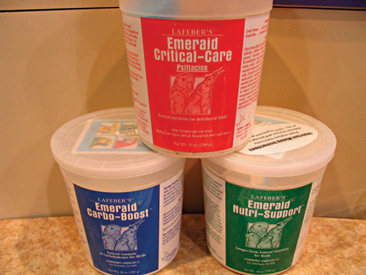
Figure 10-24 There are many products, such as these critical care products, that are fed to the bird via a crop feeding tube.
Calcium is an important dietary element for companion and caged birds. Many birds on a seed diet and reproductively active hens need calcium supplementation. In general all birds should have calcium supplementation in their cage. Calcium supplementation can be provided in the form of a cuttlebone, mineral block (Figure 10-25), crushed oyster shell, or baked crushed eggshell. Most cage and companion birds do not need grit. Grit can be defined as a nondigestible, nonnutritional dietary aid to crush food material in the ventriculus (e.g., quartz). As mentioned previously, most companion and cage birds shell their seeds before ingestion. Many of the psittacine species actually crush the kernel or pellet before eating. These birds do not need grit. Crushed oyster shell will deliver calcium to the body if ingested and will possibly stay in the ventriculus to aid in crushing up food. Because crushed oyster shell has a nutritional value in that it is providing a source of calcium, it is not considered grit. Birds will eat the calcium if provided and when needed to meet physiologic demands. Cuttlebones should be placed in the cage with the soft side facing the bird. Cuttlebones are strictly a calcium source and are not beak sharpening devices. If vitamin or mineral supplementation is added to the water, the water must be changed on a daily basis. Vitamin and mineral supplements degrade starting at the time of placement into the water source. Adding vitamin and mineral supplements provides an excellent medium for bacterial growth. To reduce growth and subsequent exposure to bacteria, the water should be changed daily and the water receptacle disinfected.
The ability of the adults to feed their young without the danger of thermal burns is not the only advantage of having parent birds raise their offspring. As adult birds feed their young through regurgitation, they inoculate their young with their crops’ autochthonous bacterial flora. This autochthonous flora (beneficial bacteria) usually is comprised of Bacillus spp., Corynebacterium spp., Streptomyces spp., and Lactobacillus spp.7 The regurgitated food containing this soup of microorganisms normally proliferates within the gastrointestinal tract of the neonate, promoting digestion and providing immune support against gastrointestinal infections caused by bacteria that contribute to sour crop and diarrhea.8,9 It is common practice for aviculturists to give probiotic supplements to birds that are being hand-fed, that are showing signs of crop stasis, and/or have been taking antibiotic medication. The autochthonous flora usually colonize the crop, stomach, and intestinal tract in the first 3 to 4 weeks after hatching.9 These beneficial bacteria aid in digestion by promoting optimal environmental conditions for the breakdown of the food for utilization by the intestinal tract.1 Also, the autochthonous flora protect the bird by occupying attachment sites on the intestinal mucosa; secreting metabolic products that inhibit growth, function, and reproduction of disease-causing bacteria; and maintaining an environment with a low pH.7 There have been studies using readily available cow- and goat-processed probiotic supplements for hand-fed psittacine species, and no significant improvements in survival or growth were demonstrated.10,11 Again, this would help support the belief that nonspecies specific, in particular mammalian, obtained probiotic organisms may have minimal beneficial effects on the avian digestive system. Studies have shown that the mammalian Lactobacillus sp. reduces intestinal pH if administered daily over a period of 2 to 4 weeks, which may help with the digestive process if no other beneficial organisms are being supplemented by the hand-feeder or the parent birds.7 If the birds are supplemented an avian-specific or species-specific bacterial supplement, the beneficial bacteria will start to protect the intestinal tract at 4 to 6 weeks of age.12 At 4 to 6 weeks of age, the birds are often in a highly immunocompromised condition and remain so until they are eating food on their own. Any protection or support that an owner can give the bird at this time will be beneficial for the bird’s overall health and condition.
Fruits and vegetables are also dietary supplements that are presented as part of a bird’s diet. Fruits should be used sparingly in most bird diets because they are composed of mainly sugars and water. Some psittacine species (e.g., eclectus, lories) require a significant amount of fruit in their diet, but these are exceptions. Fruit should be offered only a couple of times a week. To reduce the cost of providing fresh fruits and vegetables, a large discount can be obtained from fruit and vegetable markets on produce that is old or unappealing to customers. As with most food products, the younger birds are when exposed to different foods, the more readily they accept diversity in their diet. Vegetables offer more of a nutritional benefit than do fruits. Fresh or cooked dark green, red, and orange vegetables should be offered on a daily basis if possible. A separate container should be in the enclosure to add any food material other than the base diet. Because of the likelihood of microorganism growth, it has been recommended that fresh fruit and vegetables or cooked food should only be left in the cage for 30 minutes.5 Vitamin and mineral supplements can be added to food as well as water. It is best to add the supplements to food in which it will adhere. Powder is likely to fall through the seed and end up in the bottom of the container. Coating the seed first with food oil (e.g., sesame) will give the supplement an attachment surface. The supplements can also be sprinkled on fresh fruit and/or vegetables or cooked foods.
Special bird diets have been formulated for certain species and for young growing birds. Lories, birds native to Australia and the South Pacific islands, eat fruit, nectar, and pollen as the main part of their diet. Powdered and liquid Lory diets are commercially available and should be provided to this species as its primary food source (Figure 10-26). Myna birds and toucans are susceptible to hemochromatosis, or iron storage disease of the liver. The iron content of many diets has resulted in special myna and toucan diets that have low iron composition. Grapes are high in iron and should not be fed to toucans, mynah birds or those avian species predisposed to iron storage disease. Tea has been advocated as a supplement that binds iron and may be used to reduce dietary iron intake in birds susceptible to hemochromatosis. Hand-raised baby birds need a liquid diet. The advent of commercially available hand-feeding formula has revolutionized the ability of bird owners to adequately feed baby parrot species. These commercially available hand-feeding diets are easy to reconstitute using warm water, and they provide the nutrition needed for proper growth and development. For most situations in which psittacine species are being hand-raised, a commercial product is preferable to homemade formulas. The use of warm water to reconstitute the powder has decreased the incidence of burned crops caused by overheated baby bird formulas that needed to be cooked before administration. If heating a baby bird formula for feeding, it must be remembered that a bird’s body temperature is approximately 103° F; therefore, the formula should be fed 2 to 3 degrees cooler than the body temperature. If the food is warmed in a microwave oven, it should be thoroughly mixed to prevent hot spots from forming within the food. Owners have the ability to control a bird’s diet, thereby having a significant effect on its overall health and quality of life. Educating the owner on recommended diets is one of the most important aspects of the postpurchase physical examination.
PREVENTIVE MEDICINE
Birds that are imported into the United States have to be quarantined in USDA facilities for 30 days. During this 30-day quarantine period, the birds are monitored for any signs of illness and may be treated with a tetracycline-impregnated food. The quarantine regulation for birds was established to prevent the introduction of velogenic viscerotropic Newcastle disease into the United States. Since the passage of the Wild Bird Conservation Act in 1992, there has been a significant reduction of parrot species importation into the United States. With the majority of companion avian species being captive bred, the widespread exposure to infectious diseases observed during the importation period appears to be reduced. At the same time there has been a significant advancement in avian medicine and surgery and general knowledge relating to husbandry, nutrition, and management.
For any disinfectant to be effective, all organic debris must be removed from the surface to be treated. Dirt or organic material cannot be disinfected through traditional methods used in aviaries with the compounds employed. A dilute sodium hypochlorite solution is the most cost-effective and efficient disinfectant one can use. Phenol-based disinfectants are more expensive than sodium hypochlorite and will effectively kill mycobacterial organisms. If newspaper or a disposable sheet paper product is placed on the bottom of cages and within baby bird containers, much of the fecal material is removed when the cage or aviary is cleaned. Outside flight cages should be elevated (Figure 10-27), which allows for raking and debris removal from the area. All birds should be removed from their cages if a volatile chemical compound is being used to disinfect the flights, cages, or enclosures. Once the smell has dissipated, the birds will be able to safely return to the area without fear of respiratory damage due to the irritating chemical compounds within the environment. The avian respiratory tract is much more sensitive to irritating environmental toxins than is the mammalian lung. The amount of volatile compound a human can withstand is significantly greater than that of a bird. It is also recommended to rinse a cage and cage bowls and toys thoroughly before placing the bird back into its enclosure. All disinfecting should take place in a well-ventilated area and strictly follow the manufacturer’s instructions regarding usage and dilutions. If wooden cage furniture or perches cannot be cleaned or disinfected, they should be discarded and new toys and/or perches procured.
Stay updated, free articles. Join our Telegram channel

Full access? Get Clinical Tree


